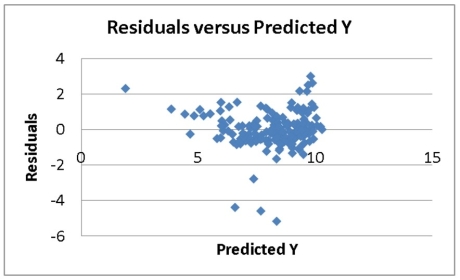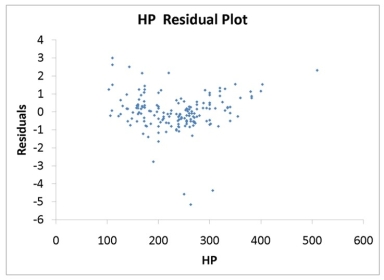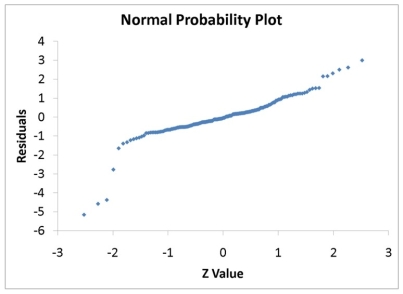TABLE 13-16
What are the factors that determine the acceleration time (in sec.) from 0 to 60 miles per hour of a car? Data on the following variables for 171 different vehicle models were collected:
Accel Time: Acceleration time in sec.
Cargo Vol: Cargo volume in cu. ft.
HP: Horsepower
MPG: Miles per gallon
SUV: 1 if the vehicle model is an SUV with Coupe as the base when SUV and Sedan are both 0
Sedan: 1 if the vehicle model is a sedan with Coupe as the base when SUV and Sedan are both 0
The regression results using acceleration time as the dependent variable and the remaining variables as the independent variables are presented below.

The various residual plots are as shown below.





The coefficient of multiple determination for the regression model using each of the 5 variables Xj as the dependent variable and all other X variables as independent variables (Rj2) are, respectively, 0.7461, 0.5676, 0.6764, 0.8582, 0.6632.
-Referring to Table 13-16, the 0 to 60 miles per hour acceleration time of a sedan is predicted to be 0.6427 seconds higher than that of an SUV.
Definitions:
Variance Data
Variance data measures the spread of a set of numbers, indicating how much individual numbers in a dataset differ from the mean.
Mean Value
The mean value is a measure of central tendency, calculated by adding all the numbers in a set together and dividing by the count of numbers.
Measure Variability
The extent to which data points in a set diverge from the average value, indicating the spread or dispersion in the data.
Interval Scales
A type of scale used in measurement that involves numerical values where the intervals between values are interpretable, but there's no true zero point.
Q2: Referring to Table 12-1, interpret the estimate
Q13: Referring to Table 11-13, the critical value
Q17: What do the indexes of living costs
Q29: Which amendment to the U.S.Constitution made it
Q139: Testing for the existence of correlation is
Q139: Referring to Table 13-17 Model 1, what
Q155: Referring to Table 12-8, what is the
Q176: Referring to Table 13-16, what is the
Q212: Referring to Table 12-4, the standard error
Q248: Referring to Table 13-16, _ of the